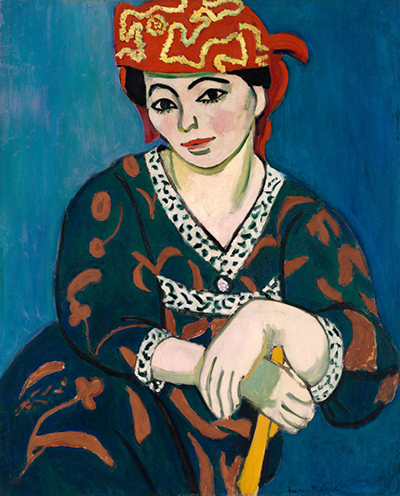This delightful portrait captures the artist's wife, Amélie Noellie Parayre Matisse, dressed in some beautifully patterned clothing, whilst leaning on a chair, looking directly at the viewer.
Henri Matisse created this painting in 1907 and it is sometimes called The Red Madras Headdress elsewhere. He believed his wife to be perfect for modelling and would use her for several different paintings, including some as double portraits with himself as well as a whole variety of other poses and environments. It was easier to organise with her as the muse, and he also realised that her beauty was well suited to the bright colour schemes which seemed to complement her aesthetics very well. Madras Rouge features a fairly standard contemporary pose, where the chair is turned to a right angle to allow the model to lean on the back whilst facing us directly and sporting a serious expression. By this point she would have already been entirely comfortable in posing for her husband and would do so many more times in the future.
The portrait places Amélie in front of a relatively flat blue background. She sports bright red headwear with a yellow pattern that brings it to your attention. Her makeup is elegant, and not over done, with red lipstick and additions to her cheeks and eyes. Her dress is blue and brown, again patterned, with a white collar and sleeves. The dimensions of her body were not considered 'correct' by some academics and so this painting was not well received at the time, though in truth the artist was simply more interested in concentrating on colour in this portrait. One cannot argue that the colour balance is stunning and makes this painting highly memorable for many. The delicate facial features of the model too, plus her unflinching gaze are also engrained in your mind almost immediately.
The painting can be found at the Barnes Foundation, a large and exciting collection of art from private purchases over a number of decades. It is based in Philadelphia, USA, and the highlights to be found here include a large number of Renoir paintings as well as specific artworks such as Toward Mont Sainte-Victoire (Cézanne), Portrait of the Postman Joseph Roulin (Van Gogh) and Le Bonheur de Vivre (Matisse). The display found within the display area can sometimes be described as eccentric, but this remains a highly significant art institution which takes its place amongst the finest US collections of European art right across the entire country. Most institutions have actually been donated much of their work through generous locals over a number of years, but in the case of the Barnes Foundation, the venue was set up specifically to show off a single collection in all its glory and to allow others to appreciate the great work that had been collated over a large number of years.




